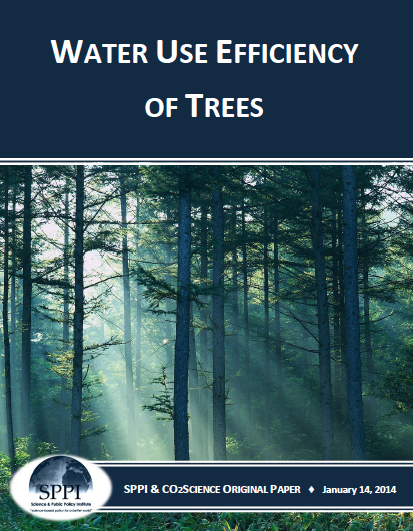News / Nature
WATER USE EFFICIENCY OF TREES

The effect of elevated atmospheric CO2 concentrations on the water-use efficiencies of trees is clearly positive, having been documented in a number of different single-species studies of longleaf pine (Runion et al., 19991), red oak (Anderson and Tomlinson, 19982), scrub oak (Lodge et al., 20013), silver birch (Rey and Jarvis, 19984), beech (Bucher-Wallin et al., 20005; Egli et al., 19986), sweetgum (Gunderson et al., 20027; Wullschleger and Norby, 20018) and spruce (Roberntz and Stockfors, 19989). Likewise, in a multi-species study performed by Tjoelker et al. (1998)10, seedlings of quaking aspen, paper birch, tamarack, black spruce and jack pine, which, were grown at 580 ppm CO2 for three months, displayed water-use efficiencies that were 40 to 80% larger than those exhibited by their respective controls grown at 370 ppm CO2.
Similar results have also been obtained when trees were exposed to different environmental stresses. In a study conducted by Centritto et al. (1999)11, for example, cherry seedlings grown at twice-ambient levels of atmospheric CO2 displayed water-use efficiencies that were 50% greater than their ambient controls,regardless of soil moisture status. And in the study of Wayne et al. (1998)12, yellow birch seedlings grown at 800 ppm CO2 had water-use efficiencies that were 52 and 94% greater than their respective controls, while simultaneously subjected to uncharacteristically low and high air temperature regimes, respectively.
In some parts of the world, perennial woody species have been exposed to elevated atmospheric CO2 concentrations for decades, due to their proximity to CO2-emitting springs and vents in the earth, allowing scientists to assess the long-term effects of this phenomenon. In Venezuela, for example, the water-use efficiency of a common tree exposed to a lifetime atmospheric CO2 concentration of approximately 1,000 ppm rose 2-fold and 19-fold during the local wet and dry seasons, respectively (Fernandez et al., 199813). Similarly, Bartak et al. (1999)14 reported that 30-year-old Arbutus unedo trees growing in central Italy at a lifetime atmospheric CO2 concentration around 465 ppm exhibited water-use efficiencies that were 100% greater than control trees growing at a lifetime CO2 concentration of 355 ppm. Also, two species of oak in central Italy that had been growing for 15 to 25 years at an atmospheric CO2 concentration ranging from 500 to 1000 ppm displayed "such marked increases in water-use efficiency under elevated CO2," in the words of the scientists who studied them, that this phenomenon "might be of great importance in Mediterranean environments in the perspective of global climate change," as suggested by the work of Blaschke et al. (2001)15 and Tognetti et al. (1998)16. Thus, the long-term effects of elevated CO2 concentrations on water-use efficiency are likely to persist and increase with increasing atmospheric CO2 concentrations.
